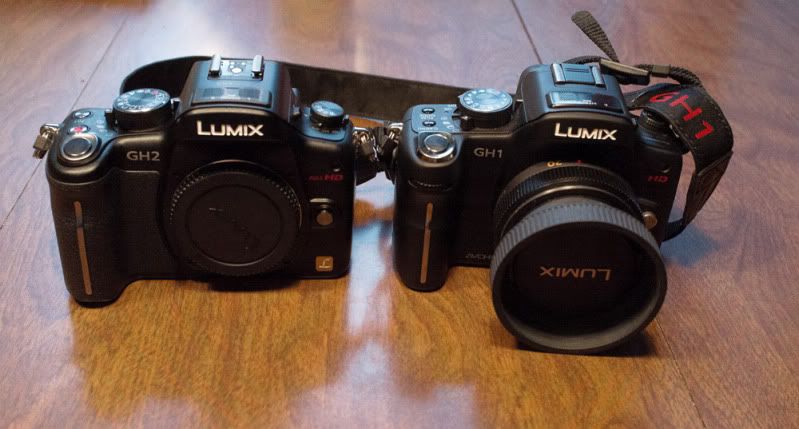
A Line of Fall Maples ( Panasonic GH1, Lumix 45-200mm f4)
Amazon is a wonderful retailer. I thought this as I printed off the return labels for my latest purchase from them.
They make it very easy to return things, which I think sometimes is a service under-utilized by those of us who frequently purchase electronics and particularly cameras. Newer is not always better. It is important to be able to discern when a new purchase will actually improve your ability to actually capture images, vs. when the new item merely answers need for something new and novel.
In September, I found myself in a mood to buy a new piece of camera gear. I definitely “get the itch” once in a while, though often, if there is nothing new and compelling on the market, I try to resist.
I had been awaiting several model introductions. In terms of my micro 4/3 gear, I’ve been shooting the Panasonic GH1 for several years now and began to think I would like an upgrade. I’ve been looking at the Olympus OM-5. Certainly it receives rave reviews, and its image quality is apparently first-rate. My problem is that I do not believe the kit lens (the 12 – 50mm F3.5 – 6.3) is the best optic to purchase for the system, and body only OM-5’s were at the time, difficult to find. So I decided to wait for the GH2 replacement.
This replacement was announced at Photokina several weeks ago. The GH3 has several features we’ve been waiting for including a weather-sealed body and apparently a higher quality sensor. For me however it has several critical flaws including the loss of the multi aspect feature of the previous series sensor (allowing 16:9 crops without much resolution loss). More importantly it is significantly bigger than the previous series camera which completely negates one of my favorite features of the G-series, mainly their diminutive size. So for the time being at least, the GH3 is “off the table”.
So I did some searching on the web on the various 4/3 bodies, focusing on features and image comparisons. I read multiple reviews and after some deliberation, decided to give my current cameras replacement, the GH2 a try. This camera was a mild refresh of the GH1, with at high-resolution sensor (16 vs. 12 mega pixels) better video which is not really an issue to me, and a touch screen interface on the LCD. The best price I did find was on Amazon, so I ordered it up.

Both Cameras (Fujifilm X-100)
It arrived several days later, on a Friday afternoon and I look forward to spending a weekend shooting some early autumn foliage with my new acquisition.

Dancing Ferns (Panasonic GH2, Lumix 14-45mm f3.5)
The first thing I noticed was that the new body was much more “plasticy” than my GH1. As the construction of the newer camera is said to be the same I didn’t completely understand this at first, until I examined the old body in comparison. Until the GH2, G-series cameras were covered entirely in a rubber coating that was extremely tactile, and managed to obscure construction of the body beneath, which given the density the camera almost feels metallic. The new camera offered no such solutions and seemed cheaper…not to mention more likely to slip out of one’s grip.

Maples on Fourth Run Trail( Panasonic GH2, Lumix 14-45mm f3.5)
One of the nice features of the GH1 was the rear LCD. This screen is fully articulated, covered in clear glass, with fairly high-resolution that has always made it easy to review ones images. The GH 2 LCD has similar articulation, but now looks significantly different with a matte finish cover. I suspect that the change has to do with the touch screen function of the LCD. Unfortunately the new screen is not nearly as sharp and to my eye, makes it much more difficult to review images in terms of for instance, critical sharpness. Plus the touch screen feature to me is not particularly attractive, as generally I try to keep my fingerprints off the LCD screen. I’m perfectly happy controlling the camera’s functions from the buttons and menus.
I took both the GH1 and GH2 out on a walk, and shot them against each other, switching out the Lumix 20mm f1.7 lens, and shooting from a tripod. I could detect little if any difference in detail capture or noise characteristics between the two sensors despite the increase in megapixels, and the additional development time of the newer sensor (the test site Dx0 Mark rates the older sensor as the better of the two).

Duckbox on Frog Pond Way( Panasonic GH2, Lumix 20mm f1.7)
Here are some shots from my backyard, of the familiar shed I use as a target, again shot with the GH1 , GH2 and the same Lumix 20mm lens. I can’t say that there’s no difference, but certainly the difference in minimal.

Shed, GH2

Shed, GH1
Another problem with the GH2 was the change in the control wheel between the earlier G series cameras and the GH2. The earlier cameras had the control wheel on the front grip, raised enough from the grip surface to easily utilize the push function of the wheel. On the new camera the wheel is on the back of the body, difficult to locate and nearly flush with the housing surrounding it. I found it much less intuitive and ergonomic.
Now I hear that the GH2 has much better video abilities compared to the GH1. This would be great, except that the latter camera already has better video than I really need right now.
So I packaged up the GH2, and sent it back to Amazon, long before the very generous 30 day return period expired. I could see no advantage to the product in my usual workflow.

Pocono Cabin in late September ( Panasonic GH1, 45-200mm f4.0)
Now several weeks later, I see that OM-5s are becoming available body only. Looming on the horizon however is the Fujifilm XE-1 to use with an emerging system of great Fuji lenses.
No matter, because I still love to shoot the older Panasonic, perhaps even more now, having been exposed to its newer alternative.





